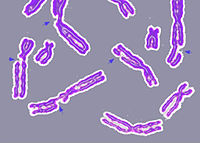
Photo from wikipedia
Gene editing enables scientists to make precise changes to the genome of an organism using the cell’s own ability to repair damaged DNA using a supplied DNA template. In recent… Click to show full abstract
Gene editing enables scientists to make precise changes to the genome of an organism using the cell’s own ability to repair damaged DNA using a supplied DNA template. In recent years, gene editing has been applied clinically in the treatment of diseases such as cancer. Gene editing has been used in a type of immunotherapy, known as chimeric antigen receptor‐expressing T cell (CAR‐T) therapy, to restore the body’s ability to find and kill specific cancer cells. For this therapy, viruses are often used to supply the cell with the DNA template used for creating the edit in the target DNA. However, the use of viruses in this context is laborious and costly. Developing non‐viral methods for delivery of DNA templates for gene editing would circumvent these problems, but current methods can have toxic effects on cells and result in low editing efficiency. In a new article published in this issue, Yang et al. describe a novel method for viral‐independent delivery of naked DNA and its incorporation into the genome for engineering cells for CAR‐T therapy.
Journal Title: FEBS Open Bio
Year Published: 2021
Link to full text (if available)
Share on Social Media: Sign Up to like & get
recommendations!